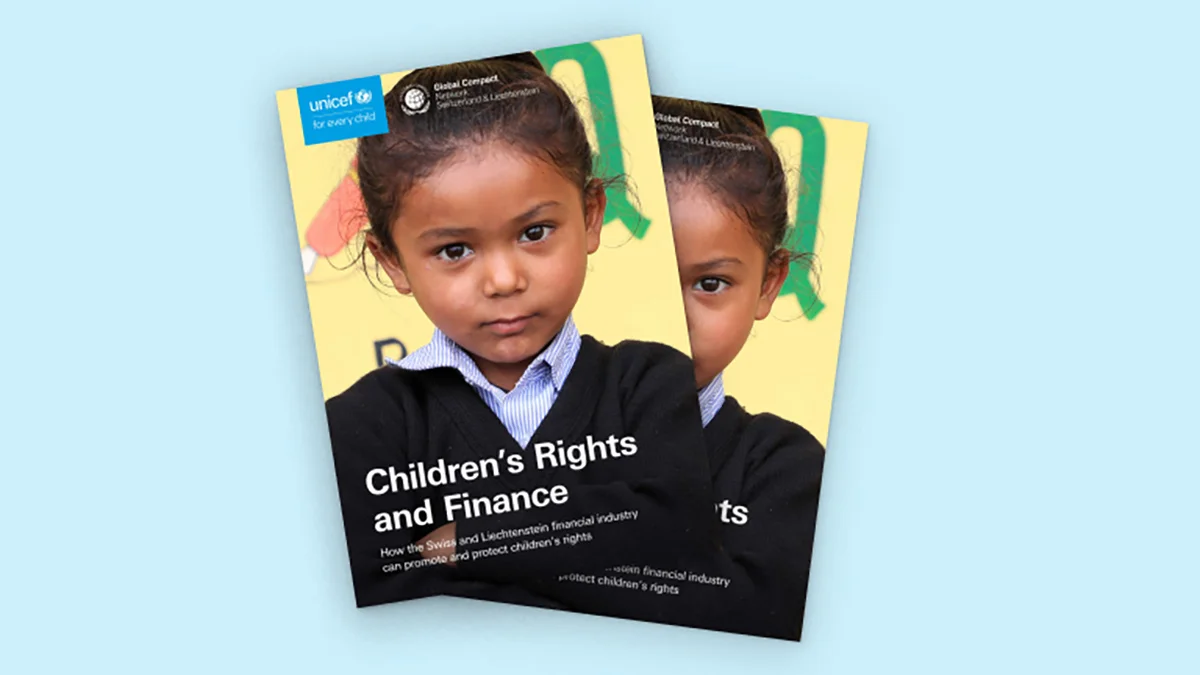A new study by UNICEF Switzerland and Liechtenstein and the UN Global Compact Network Switzerland & Liechtenstein examines the extent of influence that banks, wealth and asset managers, and insurance companies in Switzerland and Liechtenstein have on the lives of children and how they can help protect children’s rights.
Financial institutions make decisions on loans, investments and underwriting that affect businesses in all sectors. Given the global reach of these institutions and the variety of industries involved, these decisions can have both positive and negative impacts on children. Positive impacts, for example, include better living conditions and health for children through sustainable or thematic investment products and children’s savings accounts. Negative impacts include lending to companies that do not pay their workers a living wage, investing in companies that employ children for hazardous work or insuring projects that require the resettling of entire communities, including children.
The study “Children’s Rights and Finance: How the Swiss and Liechtenstein financial industry can promote and protect children’s rights” is the first such study to examine the influence that Swiss and Liechtenstein banks, asset managers and insurance companies have on the lives of children and how these financial institutions can protect children’s rights. The study focuses on the banking, investment and insurance industries and is intended to increase awareness for corporate responsibility in observing and promoting children’s rights. “Children make up one third of the world’s population, and they have the right to have their perspectives considered in decisions that affect them,” says Bettina Junker, Executive Director of UNICEF Switzerland and Liechtenstein. “It’s up to financial institutions to make active contributions toward a better today and tomorrow for our children. They can do this through proactive engagement with clients and investee companies to promote children’s rights or through new and innovative products that place children at the center of their strategy,” says Bettina Junker.
Findings: Limited awareness and perceived materiality
The majority of the 30 financial institutions in Switzerland and Liechtenstein examined in this study recognize their responsibility to respect human rights, but they lack sufficient awareness of children’s rights beyond the topic of child labor and are not taking sufficient action to uphold children’s rights.
Our research indicates that there is a tendency to view children's rights as a subset of human rights within global supply chains. The financial sector’s current approach to children is largely reactive, often limited to risk management procedures and to prohibiting child labor within supply chains. This narrow perspective can lead to financial institutions failing to comprehensively address children’s rights when pursuing their own business agendas.
Moreover, children’s rights are perceived as not sufficiently material for the financial sector, and they must compete with other important sustainability topics that command financial institutions’ fuller attention – topics such as climate change, nature and diversity. Children’s rights considerations are also seen as difficult to implement because of the broad scope of the topic, insufficient data, perceived lack of leverage and limited internal resources.
Opportunities for improvement
In spite of these limitations, financial institutions are well positioned to improve the situation of children through the integration of children’s rights in their governance, their strategy and double materiality assessments, the consideration of children in their net-zero transition plan, proactive engagement with clients and investee companies, and participation in multi-stakeholder initiatives. The use of a child-lens approach in looking at their products and services allows financial institutions to determine where their activities have negative impacts on children and gives them the opportunity to turn these negative impacts into positive ones.
Recommendations for financial institutions and other important stakeholders
This study is based on international standards and best-practice guidance, a comprehensive analysis of 30 Swiss and Liechtenstein financial institutions’ publicly reported commitments and actions regarding children’s rights, and interviews with six financial institutions headquartered in Switzerland and Liechtenstein. The findings of this study have yielded ten recommendations for banks, asset and investment managers, insurance companies and other important stakeholders in the financial industry. These recommendations are intended to strengthen these institutions’ commitment to children’s rights. They include the following:
- Financial institutions should apply a “child-lens approach” to governance, strategy, risk management and products and services, and commit to upholding children’s rights.
- Financial institutions should consciously consider children’s rights in their double materiality assessments. If concerns about children’s rights are identified as material, they should be disclosed in the institution’s reporting, describing the connections to children’s rights, potential positive and negative impacts, risks and opportunities, and the measures taken by the financial institution to address them.
- Financial institutions should practice stewardship and engagement with clients and investee companies to improve their business practices. Financial institutions should not simply exclude business with clients and investee companies that present high risk of exposure to child labor and practice weak due diligence to mitigate such risks. Instead, they should use or increase leverage with clients and investees to influence how they identify and address child labor and children’s rights in general.
Click here to read the study: Children’s Rights and Finance | unicef.ch



